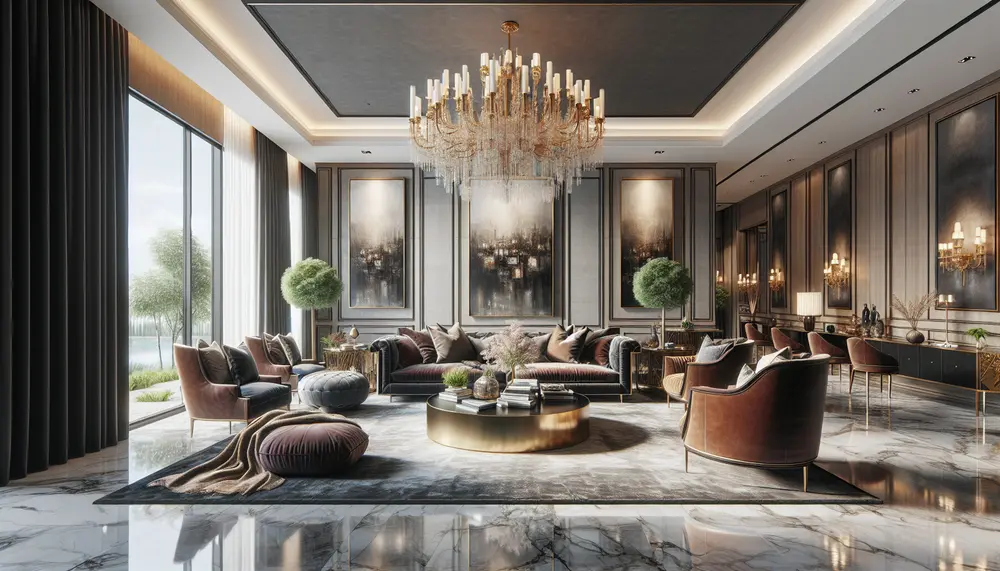Table of Contents:
Creating a Luxurious Atmosphere with Color and Material Choices
When it comes to crafting a luxurious atmosphere, the choices you make in colors and materials can transform a space from ordinary to extraordinary. Start by selecting a neutral color palette that exudes calm and sophistication. Think shades of soft beige, elegant greys, and muted pastels. These hues provide a serene backdrop that allows other design elements to shine.
Materials play a pivotal role in defining luxury. Opt for high-end finishes like polished marble, rich velvet, and sleek metals. These materials not only look opulent but also feel exquisite to the touch. The tactile experience is just as important as the visual one, so consider how each material interacts with light and space.
Layering different textures can add depth and interest to your design. Combine the smoothness of silk with the warmth of wood or the coolness of glass. This interplay of textures creates a dynamic environment that feels both inviting and exclusive.
Remember, the key to a luxurious atmosphere is balance. While it’s tempting to go all out with lavish materials, restraint is often the hallmark of true elegance. Let each piece speak for itself, and ensure that your color and material choices work harmoniously to create a cohesive and stunning design.
Investing in High-Quality Furnishings
Investing in high-quality furnishings is a cornerstone of luxury design. The right pieces not only elevate the aesthetic of a room but also enhance its functionality and comfort. When selecting furniture, prioritize craftsmanship and durability. Look for pieces made from premium materials like solid wood, fine leather, and expertly woven fabrics.
Consider the design pedigree of the furniture. Iconic designs from renowned designers often hold their value and become timeless additions to your home. These pieces can serve as focal points, drawing attention and admiration from anyone who enters the space.
Functionality should not be sacrificed for style. Choose furnishings that are both beautiful and practical. A well-designed sofa should offer comfort and support, while a dining table should accommodate both intimate dinners and larger gatherings with ease.
Customization is another avenue to explore. Many luxury brands offer bespoke options, allowing you to tailor furniture to your specific tastes and needs. This personal touch ensures that each piece fits perfectly within your overall design scheme, adding a unique flair to your home.
Ultimately, investing in high-quality furnishings is about creating a space that reflects your personal style while providing lasting comfort and elegance. It’s an investment in your home’s future, ensuring that it remains a place of beauty and luxury for years to come.
The Role of Lighting in Luxury Design
Lighting is an essential element in luxury design, playing a crucial role in setting the mood and highlighting the finer details of a space. The right lighting can transform a room, making it feel more expansive, inviting, or intimate, depending on the desired effect.
Begin by considering the layering of light. This involves using a combination of ambient, task, and accent lighting to create a balanced and dynamic environment. Ambient lighting provides overall illumination, while task lighting focuses on specific areas where activities occur, such as reading or cooking. Accent lighting, on the other hand, is used to draw attention to architectural features or art pieces, adding depth and drama to the room.
Incorporate statement fixtures that serve as both functional elements and decorative pieces. A grand chandelier or a sleek, modern pendant can become a centerpiece, adding a touch of glamour and sophistication. The choice of fixture should complement the overall design aesthetic, whether it’s classic, contemporary, or eclectic.
Consider the color temperature of your lighting as well. Warmer tones create a cozy and inviting atmosphere, while cooler tones can make a space feel crisp and modern. Dimmable options offer flexibility, allowing you to adjust the lighting to suit different occasions and moods.
Finally, don't overlook the impact of natural light. Maximizing the use of windows and skylights can enhance the sense of space and connection to the outdoors, further enriching the luxury experience. By thoughtfully integrating various lighting elements, you can create a harmonious and visually stunning environment that elevates your home’s design.
Incorporating Art and Decorative Elements
Incorporating art and decorative elements into your luxury design is like adding the final brushstrokes to a masterpiece. These elements infuse personality and character into a space, making it uniquely yours. Art, in particular, has the power to evoke emotions and provoke thought, serving as a conversation starter and a reflection of your personal taste.
When selecting art, consider pieces that resonate with you personally. Whether it’s a bold abstract painting or a serene landscape, the artwork should complement the overall design while adding a distinct layer of interest. Don’t shy away from mixing different styles and mediums; this can create a rich tapestry of visual intrigue.
Decorative elements such as sculptures, vases, and objets d'art also play a significant role in luxury interiors. These items can be strategically placed to enhance focal points or add subtle accents throughout the room. Consider using a mix of materials, such as glass, metal, and ceramic, to introduce varied textures and finishes.
Creating vignettes or small curated displays on surfaces like coffee tables or shelves can add depth and dimension. These arrangements should be thoughtfully composed, balancing scale, color, and form to achieve a harmonious look.
Ultimately, the integration of art and decorative elements should feel intentional and cohesive, enhancing the overall aesthetic without overwhelming it. By carefully curating these pieces, you create a space that is not only luxurious but also deeply personal and engaging.
Enhancing Elegance with Scents and Architectural Details
Enhancing elegance in a luxury space goes beyond visual elements; it also involves engaging the senses in more subtle ways. One often overlooked aspect is the use of scents. A carefully chosen fragrance can evoke a sense of calm and sophistication, completing the ambiance of a room. Consider using high-quality candles, diffusers, or incense to introduce a signature scent that reflects the mood you wish to create.
Scents can be seasonal or themed, such as fresh florals in spring or warm spices in winter, adding an extra layer of depth to your design. The key is to ensure the fragrance is not overpowering but rather a gentle complement to the space.
In addition to scents, architectural details play a crucial role in elevating the luxury quotient of a room. Elements such as crown molding, wainscoting, and intricate ceiling designs add a touch of grandeur and refinement. These details create visual interest and can highlight the craftsmanship involved in the space's design.
Consider incorporating unique features like decorative moldings or custom millwork to personalize your space further. These elements can serve as a backdrop for other design features, enhancing the overall aesthetic without stealing the spotlight.
By thoughtfully integrating scents and architectural details, you can create a multidimensional experience that not only looks elegant but also feels and smells luxurious. This holistic approach ensures that every aspect of your space contributes to its overall sense of opulence and style.
Bringing Nature into Your Luxury Space
Integrating elements of nature into your luxury space can create a serene and balanced environment. Nature has a way of grounding a space, adding a sense of tranquility and freshness that enhances the overall luxury experience. One simple yet effective way to achieve this is by incorporating greenery.
Houseplants, whether large statement pieces or small potted varieties, can breathe life into a room. They not only purify the air but also add a splash of color and texture. Consider using plants like fiddle leaf figs or orchids, which are known for their elegance and ease of care.
Another approach is to use natural materials in your decor. Elements such as stone, wood, and bamboo can bring an organic touch to your design. These materials can be used in various forms, from flooring and wall coverings to furniture and decorative accents.
For those with a view, maximizing natural light and outdoor vistas can further connect your interior with the outside world. Large windows or glass doors can blur the lines between indoor and outdoor spaces, making your home feel more expansive and integrated with its surroundings.
By thoughtfully bringing nature into your luxury space, you create a harmonious blend of elegance and natural beauty. This not only enhances the aesthetic appeal but also contributes to a healthier and more inviting environment.
Personalizing Your Luxury Design
Personalizing your luxury design is all about infusing your space with elements that reflect your unique personality and style. While luxury often conjures images of opulence and grandeur, true elegance lies in the details that make a space feel uniquely yours.
Start by incorporating personal artifacts that hold sentimental value. These could be family heirlooms, travel souvenirs, or even a collection of books that tell your story. Displaying these items thoughtfully can add depth and character to your design.
Consider creating a gallery wall with personal photographs or artwork that resonates with you. This not only serves as a visual focal point but also adds a layer of intimacy and warmth to the space. Mixing different frame styles and sizes can create an eclectic yet cohesive look.
Another way to personalize your design is through customization. Whether it’s bespoke furniture, tailored window treatments, or a custom color palette, these elements ensure that your space is a true reflection of your tastes and preferences.
Finally, don’t be afraid to experiment with bold choices that speak to your individuality. Whether it’s a vibrant accent wall, an unusual piece of art, or a statement piece of furniture, these elements can add a touch of surprise and delight.
By weaving personal touches into your luxury design, you create a space that is not only beautiful but also deeply meaningful. This approach ensures that your home is a sanctuary that resonates with who you are and what you love.
Luxury Design Essentials for Home
What color palettes are recommended for luxury design?
Neutral color palettes such as soft beige, elegant greys, and muted pastels are recommended. They create a calm and sophisticated backdrop, allowing other design elements to stand out.
How important are high-quality furnishings in luxury design?
Investing in high-quality furnishings is crucial. They not only elevate the aesthetic but also provide durability and comfort, reflecting both personal style and lasting elegance.
What role does lighting play in luxury interior design?
Lighting is essential in luxury design as it sets the mood and emphasizes the finer details. Using a combination of ambient, task, and accent lighting helps create a balanced and dynamic environment.
How can art and decorations enhance a luxury space?
Art and decorative elements infuse personality into a space. Carefully selected pieces can evoke emotions and add depth, serving as focal points and creating a unique and engaging atmosphere.
What are some ways to incorporate nature into luxury interiors?
Incorporating nature through greenery, natural materials, and maximizing natural light can create a serene and balanced environment, enhancing the overall luxury experience and bringing a sense of tranquility.






